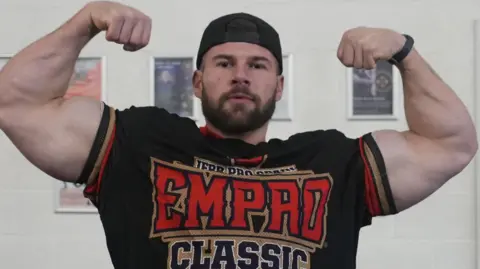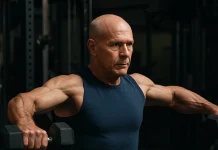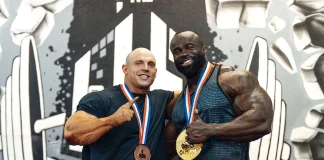Last Updated on February 14, 2025
Chiseled physiques dominate social media and fitness culture, the dark underbelly of steroid use remains a taboo topic—until stories like Joey Farrell’s emerge. At 30, Joey, a professional bodybuilder from Wales, was diagnosed with steroid-induced heart failure, a condition typically seen in elderly lifelong smokers. Yet, despite the grim prognosis—a potential 20-year reduction in his lifespan—he continues using anabolic steroids, torn between his career and survival. His story, alongside warnings from public figures like former Love Island star Tom Powell and experts like Professor Jim McVeigh, underscores a growing public health crisis. This article delves into the realities of steroid abuse, its irreversible health consequences, and the urgent need for systemic intervention.

Joey Farrell’s Journey: From Bodybuilding Passion to Heart Failure
Joey Farrell’s obsession with bodybuilding began in his teens. By 20, he started experimenting with oral steroids, and by 21, he was injecting them. For over a decade, steroids were his gateway to competitive success—until January 2023, when routine blood tests revealed alarming troponin levels, a biomarker for heart damage.
A Shocking Diagnosis
Doctors diagnosed Joey with steroid-induced dilated cardiomyopathy, a condition where the heart’s chambers enlarge and weaken, impairing blood flow. “My heart was weak—like a 75-year-old lifelong smoker’s,” he recalls. The diagnosis left clinicians stunned, highlighting a gap in medical understanding of steroid-related harm in young adults.
The Psychological Toll
For Joey, bodybuilding isn’t just a hobby; it’s his identity. The prospect of quitting plunged him into depression. “That time was dark,” he admits. Remarkably, just 16 weeks post-diagnosis, he returned to competitions, albeit with reduced steroid dosages. His rationale? “Bodybuilding’s my life.” Yet, he acknowledges the paradox: “I’m shaving at least 20 years off my lifespan.”

Tom Powell’s Cautionary Tale: Gynecomastia and Public Accountability
Joey isn’t alone. Tom Powell, a former Love Island contestant, underwent surgery to remove breast tissue (gynecomastia) caused by steroid use. “Don’t start steroids whatsoever,” he warns. Gynecomastia—a common side effect of hormonal imbalance from steroids—is just one visible consequence of a deeper metabolic disruption. Powell’s experience reflects a cultural shift: influencers using their platforms to combat the normalization of performance-enhancing drugs (PEDs).
Understanding Anabolic Steroids: Legality, Risks, and “Bro Science”
What Are Anabolic Steroids?
Anabolic-androgenic steroids (AAS) are synthetic derivatives of testosterone, designed to enhance muscle growth and recovery. While legally classified as Class C drugs in the UK, they’re prescription-only and illegal to possess or distribute without medical authorization. Despite this, steroid seizures at UK borders surged by 26% in 2022, totaling nearly one million doses.
The Illicit Market and “Bro Science”
With no official medical guidance on steroid harm reduction, users rely on “bro science”—anecdotal advice shared in gyms and online forums. This trial-and-error approach leads to dangerous practices, such as stacking multiple compounds or megadosing. “Bodybuilders experiment in ways doctors would never endorse,” Joey explains. The lack of clinical research leaves users navigating uncharted health risks.
The Health Risks of Steroid Abuse: Beyond Heart Failure
Steroid use extends far beyond cardiovascular damage. Key risks include:
- Hormonal Collapse: Testosterone suppression, infertility, and erectile dysfunction.
- Psychiatric Effects: “Roid rage,” anxiety, and dependency.
- Physical Transformations: Baldness, acne, and gynecomastia.
- Organ Damage: Liver toxicity, kidney strain, and increased cancer risk.
For Joey, the wake-up call was heart failure, but he admits, “Every user rolls the dice with their health.”
A Public Health Crisis: Steroid Use in the UK
The Scale of the Problem
While official data is scarce, estimates suggest 500,000 Britons use steroids, with Wales alone reporting 14% of men (1.5 million) experimenting with PEDs. Over half of the 20,000 individuals using Welsh needle exchanges are steroid users, signaling widespread reliance on unregulated substances.
The Gap in Healthcare Response
Dr. Chris Saville of Bangor University notes, “Long-term consequences are poorly understood.” Most general practitioners lack training in steroid-related harm, leaving users like Joey to self-monitor through private blood tests and cardiac scans.
Harm Reduction: A Call for Regional Centers of Excellence
Professor Jim McVeigh, a substance misuse expert, advocates for regional centers of excellence to bridge the gap between steroid users and healthcare providers. These hubs would integrate:
- Specialized medical professionals.
- Needle exchange programs.
- Mental health support.
- Peer-led education to replace “bro science.”
“Preaching doesn’t work,” McVeigh stresses. “We need open dialogue to guide users toward safer choices.”
The Road Ahead: Policy, Education, and Cultural Change
Government Investment
The Welsh government has allocated £67 million to substance misuse services, including steroid-specific training for healthcare workers. However, UK-wide initiatives remain fragmented.
The Role of Influencers and Media
Public figures like Joey and Tom wield significant influence. By sharing their stories, they challenge the glorification of PEDs in fitness culture. “Maybe it’s my place to protect others,” Joey reflects.
A Plea for Awareness
Joey’s final message is stark: “If you knew the side effects, would you still take steroids?” His answer: “It’s not worth it.”
Redefining Fitness Culture
Joey Farrell’s story is a microcosm of a systemic issue—a collision of ambition, misinformation, and healthcare shortfalls. As steroid use escalates, the need for education, harm reduction, and compassionate care grows urgent. The path forward demands collaboration: medical experts, policymakers, and influencers uniting to prioritize health over aesthetics. For Joey, the cost of his career may be decades of his life, but his hope is that others choose differently.






